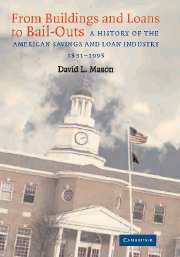 From Buildings and Loans to Bail-Outs
From Buildings and Loans to Bail-Outs Book contents
- Frontmatter
- Contents
- List of Tables
- Acknowledgments
- Introduction
- 1 A Movement Takes Shape, 1831–1899
- 2 The Rise of the League, 1900–1929
- 3 From State to Federal Oversight
- 4 The Movement Becomes an Industry, 1930–1945
- 5 The Glory Years, 1946–1955
- 6 External Challenges and Internal Divisions, 1956–1966
- 7 Lost Opportunities, 1967–1979
- 8 Deregulation and Disaster, 1979–1988
- 9 Resolving the Crisis, Restoring the Confidence, 1989–1995
- 10 The American Savings and Loan Industry in Perspective
- Appendices
- Fraud, Forbearance, and Failure: The Case of Empire Savings and Loan Association
- Success the Old Fashioned Way: The Case of Medford Cooperative Bank
- Bibliography
- Index
Fraud, Forbearance, and Failure: The Case of Empire Savings and Loan Association
Published online by Cambridge University Press: 29 October 2009
- Frontmatter
- Contents
- List of Tables
- Acknowledgments
- Introduction
- 1 A Movement Takes Shape, 1831–1899
- 2 The Rise of the League, 1900–1929
- 3 From State to Federal Oversight
- 4 The Movement Becomes an Industry, 1930–1945
- 5 The Glory Years, 1946–1955
- 6 External Challenges and Internal Divisions, 1956–1966
- 7 Lost Opportunities, 1967–1979
- 8 Deregulation and Disaster, 1979–1988
- 9 Resolving the Crisis, Restoring the Confidence, 1989–1995
- 10 The American Savings and Loan Industry in Perspective
- Appendices
- Fraud, Forbearance, and Failure: The Case of Empire Savings and Loan Association
- Success the Old Fashioned Way: The Case of Medford Cooperative Bank
- Bibliography
- Index
Summary
One of the most oft-cited reasons for the failure of thrifts in the 1980s was management fraud. The focus on white-collar crime, however, produces a misleading picture about why thrifts failed, since most insolvencies resulted from a variety of factors. One of the most important of these factors was negligence on the part of regulators to intervene in a timely manner. This problem is well illustrated in the case of Empire Savings and Loan Association of Mesquite, Texas (Empire S&LA), which failed in 1984 directly as a result of massive insider fraud. This one-office thrift made millions in loans for the construction of condominiums in an area outside Dallas, and within a matter of months grew from an institution possessing $13 million in assets to one having more than $330 million in assets. This growth caused thrift managers and their associates to became fabulously rich and the envy of the entire industry. This success, however, was not based on prudent lending practices, but instead resulted from abuses, the most grievous of which was the way thrift insiders conspired to inflate the value of the land for which they made loans. Ironically, these activities attracted the attention of regulators, and almost from the start they had some knowledge that Empire S&LA's management was engaged in fraud.
Despite such early warnings, regulators failed to act quickly to end abuses, in part because of weaknesses in their enforcement powers and in part because of bureaucratic inertia.
- Type
- Chapter
- Information
- From Buildings and Loans to Bail-OutsA History of the American Savings and Loan Industry, 1831–1995, pp. 275 - 296Publisher: Cambridge University PressPrint publication year: 2004
- 1
- Cited by


